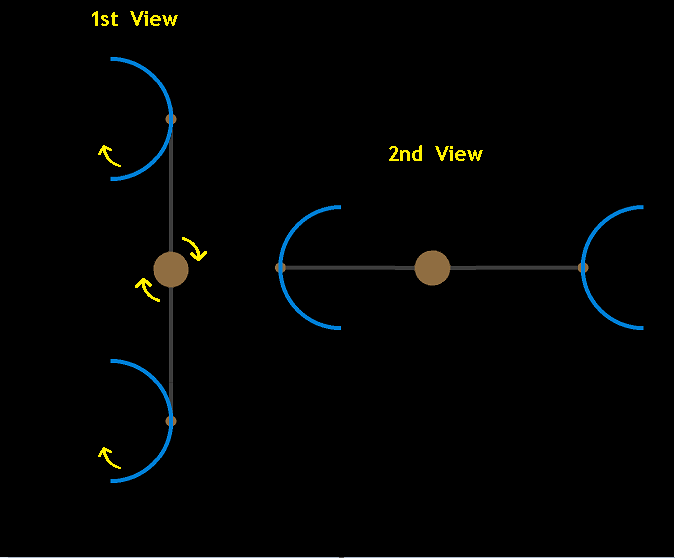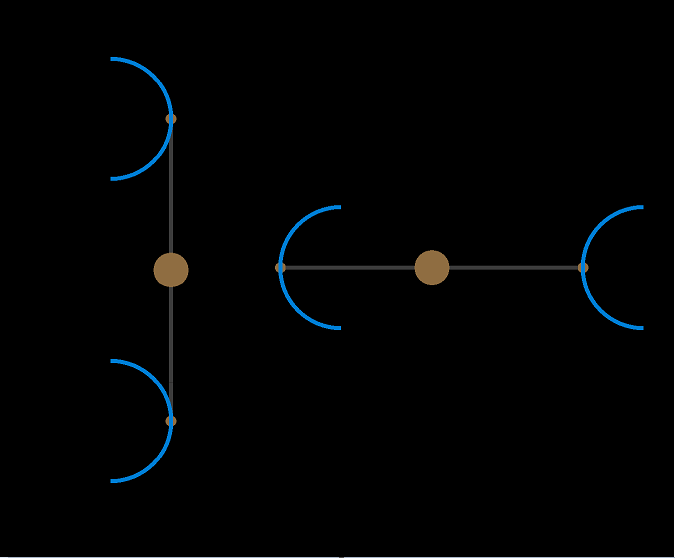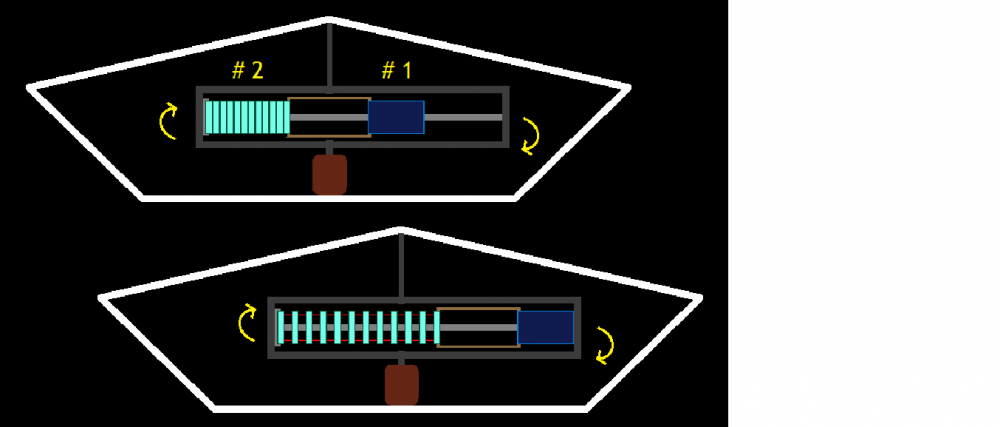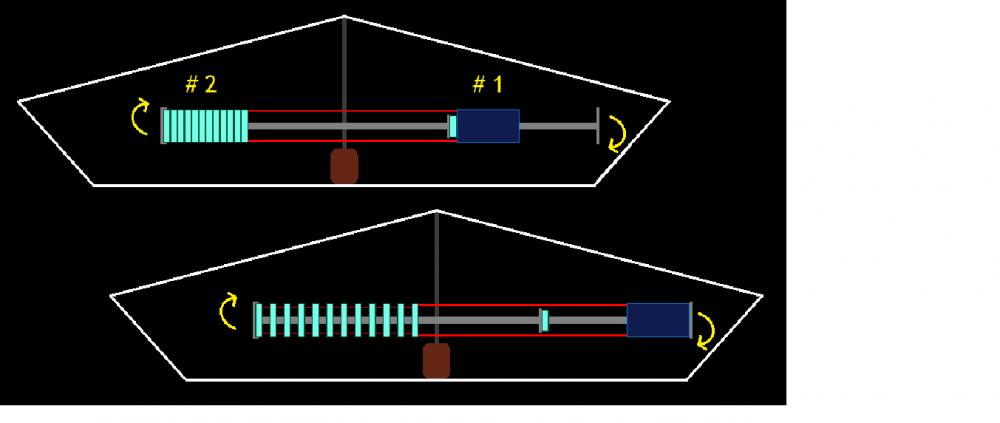-
Posts
24 -
Joined
-
Last visited
Content Type
Profiles
Forums
Events
Everything posted by StarEagle1
-

Does anyone have any thoughts about this propulsion concept?
StarEagle1 replied to StarEagle1's topic in Speculations
I really don't have much more on the concept. The middle object in there is an electric motor. Everything else, you have to figure out for yourself, but that's the fun of it. It was sort of like a hobby for me, and a way to learn a little at a time. -

Does anyone have any thoughts about this propulsion concept?
StarEagle1 replied to StarEagle1's topic in Speculations
Concerning the machine vibrating in one direction, I’m sure you must be right about the axis. Also, to me it sort of looks like it would surge forward every half rotation, but applying Newton’s third law, it should not go forward at all. I think with all the rotations on this concept it’s difficult to understand every opposite and equal reaction, at least for me. Because of that, I don’t think I’ll be completely satisfied until I try to build it one day and see that it just won’t work. I appreciate all the comments. -

Does anyone have any thoughts about this propulsion concept?
StarEagle1 replied to StarEagle1's topic in Speculations
There was one part of that description I forgot to put in. All rotations are suppose to go clockwise, I think. Now I'm done. If I attempt to build it later, I'll try to learn how things might equalize out. -

Does anyone have any thoughts about this propulsion concept?
StarEagle1 replied to StarEagle1's topic in Speculations
I (have) enjoyed it, and I think I'm done making these things up, but I'm not done learning about physics, as long as it's a little at a time. -

Does anyone have any thoughts about this propulsion concept?
StarEagle1 replied to StarEagle1's topic in Speculations
I forgot to give this simple thing a description and name.This device is suppose to propel itself on every half rotation somehow, because every half turn, one object rotates inward toward the main core while the other object rotates outward away from the main core. It's also suppose to be like a vibrating motor that only vibrates in one direction. It's name is the Off-Balance 1 Drive, or OB1 Drive, if you will. I'm surprised I haven't seen other similar devices. This one is so simple, it really is amusing! -
I should not have made that statement in that way, sorry. You may be correct, it might be better to try as soon as it seems possible.
-
I'm not a scientist, but this is so interesting I'd like to throw in a couple of speculative thoughts. If someday we could actually fly at (near) light speed, then maybe it would be easier to take the next step to FTL. Okay, hypothetically could the particles of a solid object, that are already traveling, be so energized with a strong electromagnetic field that they could then travel at a velocity of near light speed? And, if there were two objects attached to each other, would they fuse together in such a strong magnetic field? If you haven't guessed already, I'm thinking about a ship that some say disappeared, and then reappeared many miles from where it started, within a very short time.
-

Does anyone have any thoughts about this propulsion concept?
StarEagle1 replied to StarEagle1's topic in Speculations
I know, reactionless drives don't work. But, since this idea is so simple, I thought someone might be amused by it: -

Does anyone have any thoughts about this propulsion concept?
StarEagle1 replied to StarEagle1's topic in Speculations
I messed up some, but I'm still learning. Thanks for the help. -

Does anyone have any thoughts about this propulsion concept?
StarEagle1 replied to StarEagle1's topic in Speculations
Someone said that there's been other reactionless drives through history, but none have panned out. I've read a little about the EM Drive, but pretty soon I'm going to research more in order to understand better. Still though, I haven't yet found a specific reason why this propulsion concept won't work. -

Does anyone have any thoughts about this propulsion concept?
StarEagle1 replied to StarEagle1's topic in Speculations
I'm not sure about where I should ask this, but I left out a word on my last sentence. How many edits can we do, and what is the time limit to edit? Can we only edit our last post? I did a search on the word editing, but I didn't notice any rules concerning that. Is it OK to re-post my last post with a corrected version? -

Does anyone have any thoughts about this propulsion concept?
StarEagle1 replied to StarEagle1's topic in Speculations
At around 2:15 am, 3-18-2023, something came to mind about how the AgM propulsion concept might be working in a better way than I realized. Okay, when the device is spinning, say at 10k rpm, and mass #2's electromagnets disengage, then mass #1 will fly out on the rod pulling a portion of mass #2. Here it is; now when mass #1 gets to the end of the rod, it will hit the frame that is spinning with the device. That should jar the frame along with the complete whole device in that direction. At about the same time the frame is jarred, mass #2 engages it's magnets and pulls the complete whole device toward mass #1. So, I may be wrong, but there could be (3) forces together making the whole device go in the same direction at about the same time. 1.centrifugal force 2.jarring force 3.magnetic force Like I said, I could be wrong because I haven't thought about too long, or I might just be wrong period. -

Does anyone have any thoughts about this propulsion concept?
StarEagle1 replied to StarEagle1's topic in Speculations
I know, UAPs are unidentified, but I'm not sure it's a waste of time. Besides, I'm not trying to figure out a UAP drive, just a different kind of propulsion. I also don't think it's all guessing because there's at least a little science to it. I believe in using the scientific method, but right now I'm just hypothesizing with known forces like centripetal, centrifugal, and magnetic. For me, that stuff is fun. I may not be helping, but one day I hope that they come up with some kind of technology that can speed up our space program, just in case we have a gobal catastrophe sooner than later. I think it would also be nice if there were some kind of benefits from that space tech like devices that could lift up a disabled person so they would actually be able to walk and live longer. Okay, if the propulsion concept doesn't work, why not exactly? -

Does anyone have any thoughts about this propulsion concept?
StarEagle1 replied to StarEagle1's topic in Speculations
Just replying to the last post: I disagree that it's a waste of time to try to describe, or figure out the drive of UAPs. What I mean about UAPs is that we know they exist. People (are) able to identify things in the air sometimes. -

Does anyone have any thoughts about this propulsion concept?
StarEagle1 replied to StarEagle1's topic in Speculations
I'm sorry, I disagree. I think if we know something is real, like the moon, or UAPs, and we want to do more than just look at those things, then we should try to figure out how, even if we don't know how. Also, I apologize about how some of my words came out earlier. I tried to re-edit again, but it wouldn't let me. Sorry about that. -

Does anyone have any thoughts about this propulsion concept?
StarEagle1 replied to StarEagle1's topic in Speculations
I'm not certain, but I don't think UAPs are considered reactionless, yet some look like they are closed systems. Maybe it's because they're actually working. They can do weird stuff, why can't we? -

Does anyone have any thoughts about this propulsion concept?
StarEagle1 replied to StarEagle1's topic in Speculations
I'm not sure about what name this concept should have, but for now, perhaps it could be called the Artificial Gravity Magnetic Drive, or AgM Drive. Thanks for your opinion. -

Does anyone have any thoughts about this propulsion concept?
StarEagle1 replied to StarEagle1's topic in Speculations
This may be a fix for the flaw. With this diagram, the motor no longer has a shaft going through the rod. Instead, the motor connects to a frame that goes to both ends of the rod. When the electromagnets engage, the craft may have a greater chance of moving forward because some of mass #2 has gone beyond the center of rotation and on to the side of mass #1. That will contribute to the outward force of mass #1 in combination with the magnetic force. I'm hoping it will be enough force to take the whole kit and kaboodle forward. If it doesn't, perhaps some adjustments could be made. I was thinking that both masses could be moved closer to the center of rotation, which would allow more of mass #2 to go over to the side of mass #1, giving it more forward propulsion. Does this stuff sound right? -

Does anyone have any thoughts about this propulsion concept?
StarEagle1 replied to StarEagle1's topic in Speculations
AgM1.bmpAs in my first post, mass #1 and mass #2 are equal in weight and do not oscillate. At one point all electromagnets disengage and immediately engage which is suppose to take the device forward because mass #1 is further from the center of rotation than mass #2. I tried to put a picture in here, but I'm not sure if it took. Well, I decided to make the craft a boat rather than a car with wheels because a boat is lighter and easier. Okay, here's what I think the flaw is: The device is suppose to go forward as the electromagnets engage and come back together. The rod is suppose to be going back through mass #1 as mass #2 comes toward mass #1. That doesn't work because the rod in this picture (now) has a vertical shaft through it, and that's connected to a motor and the craft, which makes the rod too heavy to go forward. Anyway, I think I may have a possible fix for it. Does anybody have any thoughts on this? -

Does anyone have any thoughts about this propulsion concept?
StarEagle1 replied to StarEagle1's topic in Speculations
My power has been out most of the week at home, so I'll continue working on the diagram next week. Also, I may have a possible fix for that flaw. -

Does anyone have any thoughts about this propulsion concept?
StarEagle1 replied to StarEagle1's topic in Speculations
Okay, since I said the word (craft) earlier, I should say that, hypothetically this device is a craft which has four wheels and rolls on a flat surface horizontally. A craft that flies would probably require too much explaining right now. I'm just interested in seeing if the concept will work for the moment. I wouldn't mind talking about flying later, if we get that far. I hope to have a diagram for it by next week or so. -

Does anyone have any thoughts about this propulsion concept?
StarEagle1 replied to StarEagle1's topic in Speculations
I'm working on a diagram, but it's going to take quite a while. In the mean time, let me elaborate on some things. *The reason mass #2 is suppose to pull itself closer to mass #1 is because mass #2 has the electromagnets and is lighter in weight at the time. I picture it sort of like when a person holds a little magnet and takes it close to the refrigerator, the little magnet pulls itself to the frig and not the other way around. *The other thing is that when you have two opposite rotating objects, and one of them is heavy, but the other is light, they can still rotate without oscillating if the heavier one is closer to the center of rotation. I think that's sort of what's happening with this device. When the electromagnets engage, mass #2 is closer to the center of rotation, but it's too heavy to pull itself closer to mass #1. It's too heavy because it's connected to the rod, which is connected to a vertical shaft, which is connected to the craft near the center of rotation. I hope all that's right, and I hope it helps. -

Does anyone have any thoughts about this propulsion concept?
StarEagle1 replied to StarEagle1's topic in Speculations
2-22-2023, I found a possible flaw. When mass #2 pulls itself closer to mass #1, and the center of rotation moves closer to mass #1, mass #2 is not only pulling itself, but is also pulling the frame of the craft, essentially the whole craft, toward mass #1. That's because the center of rotation is connected to the frame. That adds a lot more weight to the equation. Does anyone know of a fix for this, or could I be wrong about it? -
I do understand that most likely, it will not work, but it'll be fun to learn, I hope. I haven't worked out a lot of details or bugs yet, but here it is: Okay, we have two rotating masses of equal weight. Mass #1 is on one side, and mass #2 is on the opposite side at an equal distance, so there should be no oscillating. What connects them is a non-magnetic cylinder-shaped rod. Mass #1 is possibly made up of batteries, etc. that surround the rod. Mass #2 is made up of a bunch of somewhat skinny, ring electromagnets, and each one has a hole through the middle. The connecting rod goes through the magnet holes and is attached to the magnet that is furthest out. At an equal distance between the masses is the center of rotation. Part of the rod that is at mass #1 extends farther out to allow that mass to slide outward. Of course now, we have to add the weight of the extra length of rod to the weight of mass #1, then even-out the weight to match the weight of mass #2. Mass #1 also has one electromagnet that is stuck to a steal plate which is attached to the rod. Even more, mass #1 is connected to mass #2's most inward magnet via wires. Now, here's what the device is suppose to do: As the equal masses rotate, all electromagnets stay engaged. At one certain point all the electromagnets disengage. Then, mass #1 slides outward on the rod. As it slides, it pulls (only) a portion of mass #2 with it. All the electromagnets of mass #2 start to pull apart, but are connected with wire so they don't pull too far from each other. Mass #1 pulls mass #2's electromagnets almost to the center of rotation. Then, immediately all the electromagnets engage again and they come together. When they do this, since mass #1 is further away from the center of rotation and mass #2 is closer, mass #1 now has greater mass and weight, which hopefully pulls mass #2 towards itself a lot more than mass #2 pulls back. As mass #1 pulls mass #2 closer, the rod slides back through mass #1 and outward. At the same time, the center of rotation moves closer to mass #1, and then evens-out the weight again. All this is suppose to happen on one side of the circle of rotation creating propulsion. Question: Hypothetically, when the electromagnets engage, does mass #1 pull mass #2 closer to itself, or does mass #2 pull itself closer to mass #1 ?





